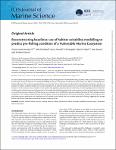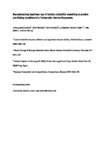Reconstructing baselines: use of habitat suitability modelling to predict pre-fishing condition of a Vulnerable Marine Ecosystem
| dc.contributor.author | Downie, A-L | |
| dc.contributor.author | Piechaud, Nils | |
| dc.contributor.author | Howell, Kerry | |
| dc.contributor.author | Barrio Froján, C | |
| dc.contributor.author | Sacau, M | |
| dc.contributor.author | Kenny, A | |
| dc.date.accessioned | 2022-02-08T13:31:25Z | |
| dc.date.accessioned | 2022-02-14T10:31:47Z | |
| dc.date.issued | 2021-11 | |
| dc.identifier.issn | 1054-3139 | |
| dc.identifier.issn | 1095-9289 | |
| dc.identifier.uri | http://hdl.handle.net/10026.1/18766 | |
| dc.description.abstract |
As industrialized fishing activities have moved into deeper water, the recognition of Vulnerable Marine Ecosystems (VMEs) has become important for the protection of the deep-sea. Our limited knowledge on the past and present distribution of VMEs hinders our ability to manage bottom fisheries effectively. This study investigated whether accounting for bottom fishing intensity (derived from Vessel Monitoring System records) as a predictor in habitat suitability models can (1) improve predictions of, and (2) provide estimates for a pre-fishing baseline for the distribution and biomass of a VME indicator taxon. Random Forest models were applied to presence/absence and biomass of Geodia sponges and environmental variables with and without bottom fishing intensity. The models including fishing were further used to predict distribution and biomass of Geodia to a pre-fishing scenario. Inclusion of fishing pressure as a predictive term significantly improved model performance for both sponge presence and biomass. This study has demonstrated a way to produce a more accurate picture of the current distribution of VMEs in the study area. The pre-fishing scenario predictions also identified areas of suitable Geodia habitat that are currently impacted by fishing, suggesting that sponge habitat and biomass have been impacted by bottom trawling activities. | |
| dc.format.extent | 2784-2796 | |
| dc.language | en | |
| dc.language.iso | en | |
| dc.publisher | Oxford University Press (OUP) | |
| dc.relation.replaces | http://hdl.handle.net/10026.1/18698 | |
| dc.relation.replaces | 10026.1/18698 | |
| dc.subject | baseline | |
| dc.subject | benthic habitat | |
| dc.subject | bottom trawling | |
| dc.subject | deep sea | |
| dc.subject | habitat distribution | |
| dc.subject | habitat suitability modelling | |
| dc.subject | human impact | |
| dc.subject | Vulnerable Marine Ecosystems | |
| dc.title | Reconstructing baselines: use of habitat suitability modelling to predict pre-fishing condition of a Vulnerable Marine Ecosystem | |
| dc.type | journal-article | |
| dc.type | Journal Article | |
| plymouth.author-url | https://www.webofscience.com/api/gateway?GWVersion=2&SrcApp=PARTNER_APP&SrcAuth=LinksAMR&KeyUT=WOS:000715387200011&DestLinkType=FullRecord&DestApp=ALL_WOS&UsrCustomerID=11bb513d99f797142bcfeffcc58ea008 | |
| plymouth.issue | 8 | |
| plymouth.volume | 78 | |
| plymouth.publication-status | Published | |
| plymouth.journal | ICES Journal of Marine Science | |
| dc.identifier.doi | 10.1093/icesjms/fsab154 | |
| plymouth.organisational-group | /Plymouth | |
| plymouth.organisational-group | /Plymouth/Faculty of Science and Engineering | |
| plymouth.organisational-group | /Plymouth/Faculty of Science and Engineering/School of Biological and Marine Sciences | |
| plymouth.organisational-group | /Plymouth/REF 2021 Researchers by UoA | |
| plymouth.organisational-group | /Plymouth/REF 2021 Researchers by UoA/UoA07 Earth Systems and Environmental Sciences | |
| plymouth.organisational-group | /Plymouth/Research Groups | |
| plymouth.organisational-group | /Plymouth/Research Groups/Marine Institute | |
| plymouth.organisational-group | /Plymouth/Users by role | |
| plymouth.organisational-group | /Plymouth/Users by role/Academics | |
| plymouth.organisational-group | /Plymouth/Users by role/Researchers in ResearchFish submission | |
| dcterms.dateAccepted | 2021-07-27 | |
| dc.rights.embargodate | 2022-8-14 | |
| dc.identifier.eissn | 1095-9289 | |
| dc.rights.embargoperiod | Not known | |
| rioxxterms.versionofrecord | 10.1093/icesjms/fsab154 | |
| rioxxterms.licenseref.uri | http://www.rioxx.net/licenses/all-rights-reserved | |
| rioxxterms.licenseref.startdate | 2021-11 | |
| rioxxterms.type | Journal Article/Review |



